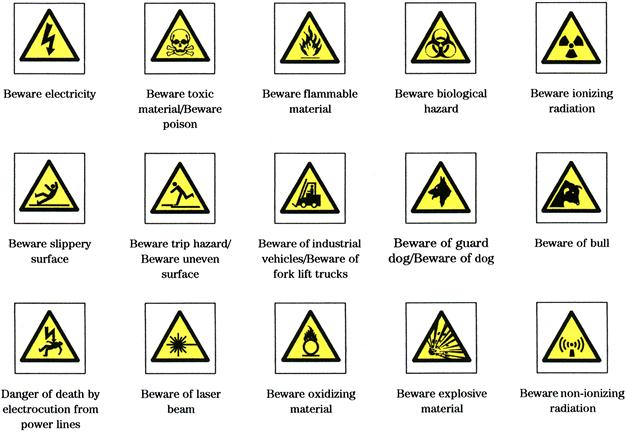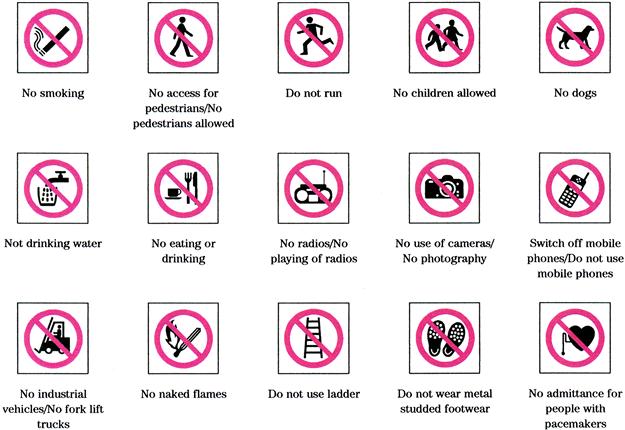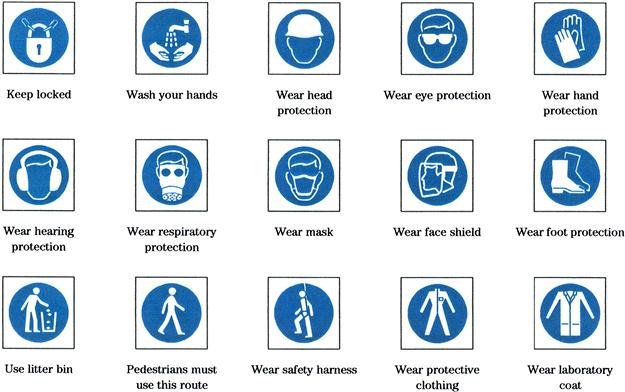Health and Safety and Environment
Abstract
This chapter emphasises the importance of safety in a project environment and lists the responsibilities of the employer, employee, and self-employed person who are all required to comply with the Health and Safety at Work Act 1974. A number of Health and Safety (H&S) regulations have been listed together with the H&S requirements relating to equipment failure, fire, electricity, hazardous substances, unhealthy conditions, poor design, unsafe operating practices, noise, and lighting. There is a section on the CDM (Construction, Design, and Management) regulations and the Health and Safety Plan. The chapter also contains an array of the most common warning signs, prohibition signs, mandatory signs, and hazard signs.
Keywords
Health and Safety; Health and Safety at Work Act; hazards; CDM regulations; warning signs; safety plan
Chapter Outline
In the light of some spectacular company collapses following serious lapses and shortcomings in safety, health and safety is now on the very top of the project management agenda. Apart from the pain and suffering caused to employees and the public by accidents attributable to lax maintenance of safety standards, the inability to provide high standards of safety and a healthy environment is just bad business. Good reputations built up over years can be destroyed in a day due to one serious accident caused by negligence or lack of attention to safety standards. In addition, under the Corporate Manslaughter Act 2007, Directors of companies can now be held responsible for fatalities caused by contraventions of H&S regulations.
It is for this reason that the British Standards Institution’s ‘Guide to project management in the construction industry’ BS 6079 Part 4: 2006 has placed the ‘S’ for safety in the centre of the project management triangle, indicating that a project manager can juggle the priorities between cost, time, and performance, but he must never compromise safety.
Health and Safety was given a legal standing with the British Health and Safety at Work Act 1974. This creates a legal framework for employers to ensure that a working environment is maintained in which accidents and unhealthy and hazardous practices are kept to a minimum.
Subsequent legislation included:
• Management of Health and Safety Regulations 1992
• Control of Asbestos at Work Regulations 1987
• Workplace (H, S & Welfare) Regulation 1992
• Personal Protective Equipment Regulation 1992
As well as a raft of European Community directives such as EC Directive 90/270/EEC.
The Act set up a Health and Safety Executive that has wide powers to allow its inspectors to enter premises and issue improvement or prohibition notices as well as instigating prosecutions where an unsafe environment has been identified. The Act also gives legal responsibilities to employers, employees, self-employed persons, designers, manufacturers, suppliers, and persons generally in control of premises where work is performed.
Each of these groups has been identified as to their responsibilities for health, safety, and welfare, which broadly are as follows.
Employer
• Provide and maintain safe equipment
• Provide safe and healthy systems
• Provide a safe and healthy workplace
• Ensure safe handling and storage of chemicals and toxic substances
• Draw up a health and safety policy statement
• Provide information, training, instruction, and supervision relating to safety issues
Employee
• Take care of one’s own health and safety
• Look after the health and safety of others
Self-employed
Designers, manufacturers, suppliers, and installers
• Must ensure designs are safe
• Must ensure testing and construction operations are safe
• Must provide information, instructions, and procedures for safe operation and use
People in control of premises
To ensure that the requirements of the Health and Safety at Work Regulations are met, employers are required to manage the introduction and operation of safety measures by:
• Setting up planning, control, and monitoring procedures
• Training and appointing competent persons
• Establishing emergency procedures
• Carrying out regular risk assessments
The Act has been given teeth by the formation of an enforcement authority called the Health and Safety Executive (HSE), which appoints inspectors with wide powers to conduct investigations, enter premises and sites, take photographs and samples, issue, where necessary, improvement or prohibition notices, and even initiate prosecution.
However, a well-run organization will make sure that visits from the HSE are not required. The watchword should always be: prevention is better than cure. Accidents do not just happen. They are caused by poor maintenance, inappropriate equipment, unsafe practices, negligence, carelessness, ignorance, and any number of human frailties.
Because accidents are caused, they can be prevented, but this requires a conscious effort to identify and assess the risks that can occur and then ensure that any possible ensuring accident or hazard is avoided. Such risk assessment is a legal requirement and does assist in increasing the awareness of health and safety and reducing the high costs of accidents.
The most common forms of accidents in commercial, manufacturing, and construction or even domestic premises are caused by:
Each of the above factors can be examined to find what hazards or shortcomings could cause an accident.
Equipment failure
• Points of entrapment or entanglement
• Ejection of finished products
• High temperatures of exposed surfaces
• Ill-fitting or insecure guards
• No safety features (overload or pressure relief devices)
• Badly sited emergency stop buttons
Fire
Electricity
• Underrated cables or switches
• No automatic circuit breakers
Hazardous substances
• Bad housekeeping, dirt, spillage
• Inadequate protective clothing
• Lack of emergency neutralising stations
Unhealthy conditions
Poor design
Unsafe operating practices
• Inadequate lifting equipment
• Inadequate handling equipment
• No obligatory rules for hard hats, boots, etc.
• No hazard warning lights, etc.
Noise and lighting
All the above hazards can be identified and either eliminated or mitigated. Clearly such a risk assessment must be carried out at regular intervals, say every six months, as conditions change, and new practices may be incorporated as the project develops.
Apart from the direct effect of accidents and health-related illness on the individual who may suffer great physical and mental pain, the consequences are far reaching. The following list gives some indication of the implications:
• Cost of repair or replacement
• Loss of market due to disruption of supply
CDM Regulations
A special set of regulations came into force in 1994 to cover work in the construction industry, which has a poor safety record. These regulations are called the Construction (Design and Management) Regulation 1994 (CDM). These are concerned with the management of health and safety and apply to construction projects including not only the client and contractors but also the designers, associated professional advisers, and, of course, the site worker. The duties of the five main parties covered by these regulations are:
1 Client
(a) Ensure adequate resources are available to ensure the project can be carried out safely.
(b) Appoint only competent designers, contractors, and planning supervisors.
(c) Provide planning supervisor with relevant health and safety information.
(d) Ensure health and safety plan has been prepared before start of construction.
(e) Ensure health and safety file is available for inspection at end of project.
These duties do not apply to domestic work where the client is the householder.
2 Designer
(a) Design structures that are safe and incorporate safe construction methods.
(b) Minimize risk to health and safety while structures are being built and maintained.
(c) Provide adequate information on possible risks.
(d) Safe designs to be inherent in drawings, specifications, and other documents.
(e) Reduce risks at source and avoid risks to health and safety where practicable.
(f) Co-operate with planning supervisor and other designers.
3 Planning supervisor
(a) Co-ordinate the health and safety aspects of the design and planning phases.
(b) Help draw up the health and safety plan.
(c) Keep the health and safety file.
(d) Ensure designers co-operate with each other and comply with health and safety needs.
(e) Notify the project to the HSE.
(f) Give advice on health and safety to clients, designers, and contractors.
4 Main contractor
(a) Take into account health and safety issues during tender preparation.
(b) Develop and implement site health and safety plan.
(c) Co-ordinate activities of subcontractors to comply with health and safety legislation.
(d) Provide information and training for health and safety.
(e) Consult with employees and self-employed persons on health and safety.
(f) Ensure subcontractors are adequately resourced for the work in their domain.
(g) Ensure workers on site are adequately trained.
(h) Ensure workers are informed and consulted on health and safety.
(j) Monitor health and safety performance.
(k) Ensure only authorized persons are allowed on site.
(l) Display the HSE notification of the project.
(m) Exchange information on health and safety with the planning supervisor.
5 Subcontractors and self-employed
(a) Co-operate with main contractor on health and safety issues.
(b) Provide information on health and safety to main contractor and employees.
(c) Provide information on health and safety risks and mitigation methods.
The CDM regulations apply to:
(a) Notifiable construction work, i.e., if it lasts for more than 30 days.
(b) Work that will involve more than 500 person days of work (approx. 4000 manhours).
(c) Non-notifiable work which involves 5 or more persons being on site at any one time.
(d) Demolition work regardless of the time taken or the number of workers.
(e) Design work regardless of the time taken or the number of workers on site.
(f) Residential property where business is also carried out.
The regulations do not apply to:
However, the requirement on designers still applies and the project must be submitted to the HSE.
Health and Safety Plan
The health and safety plan consists of two stages:
1 Pre-tender health and safety plan
This is drawn up by the employer under the direction of the planning supervisor. Its main purpose is to set a pattern for the construction phase plan and should include the following items:
(a) A general description of the work to be carried out.
(b) A programme and key milestones for the project.
(c) A table of risks envisaged at this stage and their effects on workers and staff.
(d) Information to be submitted by the contractor to demonstrate his capabilities regarding resources and management.
(e) Information to be submitted by the contractor regarding the preparation of the health and safety plan for the construction phase and welfare arrangements.
2 Construction phase health and safety plan
This plan is prepared by the main contractor and has to be submitted to the planning supervisor for approval before work can start on site. Its main constituents are:
(a) Health and safety arrangements for all persons on site or who may be affected by the construction work.
(b) Managing and monitoring the health and safety of construction work.
(c) Detailed arrangements of the site welfare facilities.
(d) Evidence of arrangements for keeping the health and safety file.
Health and Safety File
The health and safety file is a record of events on site relating to health and safety and in particular the risks encountered and their mitigations as well as possible risks still to be anticipated. The file must be handed to the client at the end of the contract to enable him to manage and deal with possible risks during the carrying out of subsequent renovations or repairs.
The planning supervisor is responsible for ensuring that the file is compiled properly as the project proceeds and that it is handed to the client at the end of the project.
The client must make the file available to all persons involved in future designs of similar structures or those concerned with alterations, additions, maintenance, or demolition of the structure.
Warning Signs
Standard warning signs have been developed to draw attention to either prohibit certain actions, take certain safety precautions, or warn of particular environmental hazards.
These signs have been colour and shape coded to indicate quickly what the type of warning is.
Thus:
• Hazard signs have a yellow background in a triangle (Figure 36.1).
• Prohibition signs are a red circle with a red diagonal (Figure 36.2).
• Mandatory signs have a blue background, usually in a round disc (Figure 36.3).
• Safe condition signs have green background in a square (Figure 36.4).
The following samples of signs, taken from BS 5499-10-2006 are the most common ones in use, but the selection is not exhaustive.




